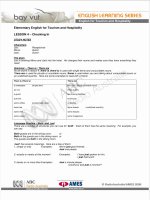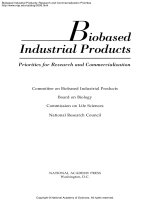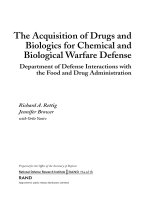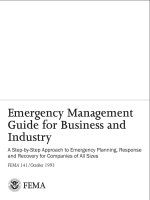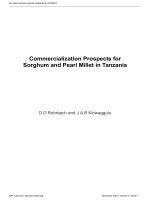- Trang chủ >>
- THPT Quốc Gia >>
- Ngoại Ngữ
METHANE-DEPENDENT DENITRIFICATION APPLICATION FOR UREA AND AMMONIUM CONTAMINATED WASTEWATER TREATMENT
Bạn đang xem bản rút gọn của tài liệu. Xem và tải ngay bản đầy đủ của tài liệu tại đây (340.2 KB, 10 trang )
<span class='text_page_counter'>(1)</span><div class='page_container' data-page=1>
<b>METHANE-DEPENDENT DENITRIFICATION APPLICATION </b>
<b>FOR UREA AND AMMONIUM CONTAMINATED </b>
<b>WASTEWATER TREATMENT </b>
<b>Vu Phuong Thu*, Nguyen Thi Quynh Trang </b>
<i>HCM City University of Natural Resources and Environment </i>
<i>*Email: </i>
<b>Received: 20 September 2019; Accepted: 19 November 2019 </b>
<b>ABSTRACT </b>
This study was conducted with synthetic wastewater from urea and ammonia
(representing nitrogen fertilizer production wastewater) and additional carbon source of
methane (CH4). Methane and air were supplied to microbial liquid phase using a bubble air
stone aerator located at the bottom of a bioreactor with methane gas flowrate ranges from 1
to 2 L/h, air flowrate ranges from 3 to 6 L/h. There were three steps in the experiment with
the first step served as acclimation period. Removal efficiency in the second step and the
third step with total nitrogen concentration range from 100 to 300 mg/L and from 300 to
600 mg/L are 98.11 ± 0.5% and 81.58 ± 1.17%, respectively. The mixed liquor suspended
solids (MLSS) at the end of step III increased by 4000 mg/L in compared with initial
microorganism density. The optimal C/N ratio of the study was 6.63 at the methane gas and
air flowrate of 2 L/h and 6 L/h, respectively. Denitrification rate reached its highest number
of 11.4 mgN/L.h while total nitrogen (TN) was supplied at 600 mgN/L. Thereby, aerobic
methane oxidation coupled to denitrification, AMO-D technology, is capable of treating
wastewater containing high TN concentration (up to 600 mg/L) but poor in organic matter
with methane as the additional source of carbon; and microorganisms could grow well in the
condition where oxygen and methane were simultaneously supplied for methane oxidation
and nitrogen removal.
<i>Keywords: Organic carbon source, methane denitrification, urea, ammonia. </i>
<b>1. INTRODUCTION </b>
Heterotrophic denitrification consists of the respiration process of microorganisms,
using nitrates as the final electron acceptor under the lack of air conditions, so that the
electron donor or organic carbon source is an important part of the process. In many real
cases, the organic carbon source is the limitation of the process and many wastewater
treatment plants have to add organic carbon to the denitrification process, especially for
wastewaters with high total nitrogen (TN) concentration but poor in organic matters.
</div>
<span class='text_page_counter'>(2)</span><div class='page_container' data-page=2>
search for an alternative source of carbon with low cost and high efficiency has been one of
the priorities of the wastewater treatment industry in the past two decades [3]. Methane is a
potential additional carbon source with low cost, suitable for biological denitrification in
organic matter-poor wastewater [4]. Currently, many wastewater treatment systems have
wastewater or sludge anaerobic digesters but do not effectively utilize the amount of
methane generated or the amount of gas is excessive for on-site reuse leading to wasteful
disposal and potentially causing fire and explosion. In addition, methane is a greenhouse gas,
so the use of methane from anaerobic digestion tanks is an appropriate option to minimize
global warming when methane is disposed indiscriminately.
Various experimental models of bioreactor with different operating methods have been
carried out to verify the process of aerobic methane oxidation combined with denitrification
(AMO-D) and many studies have been achieved positive results [5-10]. In the presence of
oxygen, methane is oxidized by aerobic oxidizing bacteria, releasing organic matter. These
organic substances are used by denitrifying bacteria that co-exist in the reactor. Soluble
organic compounds may include methanol [5], citrate [11], acetate [5, 12], proteins [12],
nucleic acids [13], and carbohydrates [14]. Methane oxidizing bacteria, methanotrophs are
widely available in nature, so it is easy to find in environments such as soil, swamps,
landfills, and mud, especially in environments where methane is produced as much as
anaerobic slurry.
Different from the studies accomplished mainly focusing on the combination of
methane oxidation and denitrification, using synthetic wastewater with nitrate as the nitrogen
source [10, 15-17], this study used wastewater synthesized from urea and ammonium, towards
a combination of methane oxidation with urea hydrolysis, nitrification and denitrification
together in a bioreactor to confirm the ability of AMO-D technology to treat nitrogen
existing in form of NH2-<sub>, NH4</sub>+<sub>, often found in domestic, livestock wastewater, leachate or </sub>
nitrogen fertilizer production wastewater. In addition, previous studies on AMO-D
technology have rarely been applied to concentrations of TN above 200 mg/L because
bacteria are likely to be inhibited when TN concentration is too high. For instance, Rajapakse
and Scutt witnessed the efficiency of denitrification process declined when TN concentration
increased [17]. Methane oxidation coupled to denitrification has been applied with
concentration of TN 20 mgN/L [10], 30 mgN/L [17], 30-40 mg/L [19], 200 mg/L [5, 6, 20]
and 100-400 mg N/L [21]. This study tests the capability of AMO-D process with high input
TN concentrations up to 600 mg/L to consider the microbiological adaptability as well as
nitrogen removal efficiency of the process.
<b>2. MATERIALS AND METHODS </b>
<b>2.1. Growth medium and culture </b>
</div>
<span class='text_page_counter'>(3)</span><div class='page_container' data-page=3>
for the experiment. The microorganisms were cultivated in a two-liter flask with the nutrient
medium to reach a MLSS concentration of 4000 mg/L at the beginning of the experiment.
<b>2.2. Configuration and operation </b>
Bioreactor was designed with an acrylic column with effective volume of 0.5 litre.
Methane and air were supplied to the liquid phase of the reactor continuously using a stone
diffuser. Methane was supplied from methane cylinder (purity of 99.95%) and air was
supplied from an air pump through an air flow meter. Plastic packing media with contact
area of 650-750 m2<sub>/m</sub>3 <sub>was used to support for attached process. Due to biological growth on </sub>
the packing material, an anoxic condition was created inside the biofilm. A half of the
medium (250 mL) was replaced every day giving a hydraulic retention time of 2 days.
The operation period is divided into 3 steps, with different regimes of gas flowrate and
total nitrogen supplied. In the first 2 steps, the nitrogen component in synthetic wastewater
was 100% urea, but in Step III they were urea and ammonia in a 1: 1 ratio. In Step I, the total
gas flowrate was kept at 5 L/hour, while the TN concentration changed stepwise from 20 to
100 mgN/L. Step I served as acclimation period. In Step II and Step III, TN concentration
varied from 100 to 300 mgN/L and from 300 to 600 mgN/L, respectively; methane and air
were supplied with different regimes as described in Table 1. The reactor was operated for
78 days overall.
<i>Table 1. The operation of the system with 3 steps </i>
Step Day Nitrogen content in
synthesis wastewater
TN concentration
inlet (mgN/L)
Total gas
flowrate (L/h)
Methane gas
flowrate (L/h)
Air flowrate
(L/h)
1 0-30 Urea 20-100 4 1 3
2 30-54 Urea 100-300 4-8 1-2 3-6
3 54-78 Urea and
ammonium 300-600 8 2 6
The system was showed in Figure 1.
</div>
<span class='text_page_counter'>(4)</span><div class='page_container' data-page=4>
<b>2.3. Analytical methods </b>
The liquid samples taken from reactor once in two days were analyzed for pH, total
nitrogen (TN) concentration and optical density at 600 nm. The mixture of gas taken from a
gas sampling port located on the top of the reactor including methane, oxygen, nitrogen and
carbon dioxide was collected for gas analysis. Methane concentration was measured using an
infrared detector (HC/CH4 RI – 415).
<i><b>3. RESULTS AND DISCUSSION </b></i>
<b>3.1. Optical density </b>
In experimental model, the bacteria concentration gradually increased in Step I while
having a lot of fluctuation in the two next steps. In the first step, the microbial density went
up to an optical density (OD) of 0.8 abs (at 600 nm) when total nitrogen concentration inlet
rose from 20 to 100 mg/L (Fig. 2). The rapid increasing of TN concentration in Step II (100-
300 mgN/L) and step III (300-600 mgN/L) affected the growth of microorganism in the
reactor, bacteria concentration went up and down in the OD range from 0.6 to 1.25 abs. The
change of nitrogen concentration in the mixed liquor made bacteria require a period of time
to adapt with new environment, thererfore sometime the bacteria concentration decreased.
However, in general, optical density increased from step I to step III, even when the TN
concentration inlet climbed to 600 mgN/L. At the end of the experiment, MLSS
concentration was 8000 mg/L, which double to the intial concentration of the model. It can
be said that microorganism could grow well in the condition where methane was supplied as
a carbon source for assimilation and denitrification in a reactor with very high nitrogen
concentration.
<b>Time (day)</b>
0 20 40 60 80
<b>O</b>
<b>p</b>
<b>ti</b>
<b>c</b>
<b>a</b>
<b>l </b>
<b>d</b>
<b>e</b>
<b>n</b>
<b>s</b>
<b>it</b>
<b>y</b>
<b> (</b>
<b>a</b>
<b>b</b>
<b>s</b>
<b>)</b>
0,4
0,6
0,8
1,0
1,2
1,4
Experimental model
Control model
Step I Step II Step III
Cin = 20 - 100 mgN/L Cin = 100 - 300 mgN/L
Cin =
300 - 600 mgN/L
<i>Figure 2. Microbial density in AMO-D bioreactor. </i>
</div>
<span class='text_page_counter'>(5)</span><div class='page_container' data-page=5>
created subtrates for the assimilation and lead to the growth of microorganism better than in
control model which was not supplied by methane.
<b>3.2. Denitrification rate </b>
In term of denitrification rate, in experimental model the rate went up almost together
with the increasing of nitrogen supplied to the reactor in each step. However, in some
specific days, total nitrogen concentration had significant increases and denitrification rate
went down (Figure 3).
<b>Time (day)</b>
0 20 40 60 80
<b>D</b>
<b>e</b>
<b>n</b>
<b>it</b>
<b>ri</b>
<b>fi</b>
<b>c</b>
<b>a</b>
<b>ti</b>
<b>o</b>
<b>n</b>
<b> r</b>
<b>a</b>
<b>te</b>
<b> (</b>
<b>m</b>
<b>g</b>
<b>N</b>
<b>/L</b>
<b>/h</b>
<b>)</b>
0
2
4
6
8
10
12
<b>T</b>
<b>N</b>
<b> c</b>
<b>o</b>
<b>n</b>
<b>c</b>
<b>e</b>
<b>n</b>
<b>tr</b>
<b>a</b>
<b>ti</b>
<b>o</b>
<b>n</b>
<b> (</b>
<b>m</b>
<b>g</b>
<b>N</b>
<b>/L</b>
<b>)</b>
0
100
200
300
400
500
600
Denitrification rate
TN conc. (inlet)
TN conc. (outlet)
TN conc. (outlet in control model)
Step I Step II Step III
<i>Figure 3. TN concentration and denitrification rate. </i>
In Step I, when TN concentration inlet rose stepwise from 20 to 100 mg/L,
denitrification rate fluctuated from 0.4 mgN/L.h to 2.26 mgN/L.h. Denitrification rate in step
II was higher than Step I and got the average value about 4 mgN/L.h. The rate reached its
highest number of the whole experiment in Step III, which was 11.4 mgN/L.h. Nitrogen was
supplied with high concentration and good performance of microorganism for the nitrogen
removal made the denitrification rate grow in Step III.
On the other hand, TN concentration outlet (experimental model) in the two first steps
was lower than in the last step. In acclimation period - step I since the bacterial concentration
was low, TN concentration outlet was relatively high, around 10-20 mgN/L but since day 18,
when optical density was almost stable above 0.7, TN concentration outlet dropped to 1.4 mg/L
and stayed at this level until the end of Step I.
</div>
<span class='text_page_counter'>(6)</span><div class='page_container' data-page=6>
<b>Time (day)</b>
0 10 20 30 40 50 60 70 80
<b>N</b>
<b>it</b>
<b>ro</b>
<b>g</b>
<b>e</b>
<b>n</b>
<b> r</b>
<b>e</b>
<b>m</b>
<b>o</b>
<b>v</b>
<b>a</b>
<b>l e</b>
<b>ff</b>
<b>ic</b>
<b>ie</b>
<b>n</b>
<b>c</b>
<b>y</b>
<b> (</b>
<b>%</b>
<b>)</b>
0
20
40
60
80
100
<b>G</b>
<b>a</b>
<b>s</b>
<b> f</b>
<b>lo</b>
<b>w</b>
<b> r</b>
<b>a</b>
<b>te</b>
<b> (</b>
<b>L</b>
<b>/h</b>
<b>)</b>
0
1
2
3
4
5
6
7
8
Methane flow rate
Air flow rate
Removal efficiency
<i>Figure 4. Removal efficiency with different gas flow rate. </i>
Due to the sudden change of TN concentration to 200 mg/L, bacteria needed time
toadjust to new conditions. Besides, mass of nitrogen to be removed was high and it
required a better mass transfer of methane to supply more soluble carbon for the
denitrification process. An increase in gas flowrate as well as mass transfer rate made a clear
change. The mass transfer appeared to be clearly important for the denitrification using
methane because of its low solubility [21]. After 4 days, TN concentration outlet went back
to low value, with 5.3 mgN/L (day 42) and 0.31 mgN/L (day 48).
In day 50, there was a change in TN concentration inlet, from 200 mgN/L to 300 mgN/L,
the TN concentration outlet went up again to 47.1 mgN/L. Total gas flow rate was gently
increased to 8 L/h to adapt with the ability of mass transfer and supply carbon source for
bacteria (Figure 4). The removal efficiency rose to 99% after two days (day 51).
The content of synthetic wastewater supplied in Step 3 including urea and ammonia
was different from its in Step 1 and Step 2, which contained only urea as nitrogen source
provided. Denitrification rate declined from 6.1 (day 54) to 5.1 (day 56), as a result, removal
efficiency dipped from 98.1% (day 54) to 81.3% (day 56). The change of content in
wastewater affected to microorganism and made the slight reducing of removal efficiency.
When TN concentration inlet grew to 400, 500 and 600 mgN/L in step III, denitrification rate
jumped to around 7.2 mgN/L.h, 9.2 mgN/L.h and 11.3 mgN/L.h, respectively. The average
efficiency in Step 3 was 81,8% and TN concentration outlet was around 43 mgN/L in
average. To compare with the QCVN 40:2011/BTNMT - National technical regulation on
industrial wastewater, the value of pollution parameter total nitrogen of industrial wastewater
in columm B was 40 mg/L, so that the TN concentration outlet in the experimental model
nearly met the standand. In this step, total nitrogen supplied went up to 600 mgN/L, the high
concentration could restrict the microorganism and make the denitrification rate drop, this issue
was mentioned in a research “Bio-removal of nitrogen from wastewater - A review” [23]. To
increase the denitrification rate and met the national requirement, the parameter of pH, C/N
ratio and microbial density should be optimized in a following research.
</div>
<span class='text_page_counter'>(7)</span><div class='page_container' data-page=7>
the nitrogen concentration inlet of 600 mgN/L. It was easy to see that methane played a very
important role in the denitrification process.
<b>3.3. C/N molar ratio </b>
The C/N molar ratio counted on the amount of methane and nitrate available in the
medium of the bioreactor changed with the variation of inlet nitrogen concentration between
100 and 600 mgN/L (Figure 5). They were calculated as below:
N available (mol/d) = [(N supplied + N remained) x 0.5L] /14 / 1000 (1)
C available (mol/d) = (CH4 in – CH4 out) (mol CH4-C/d) (2)
C/N available ratio = C available / N available (3)
<b>Time (day)</b>
28 32 36 40 44 48 52 56 60 64 68 72 76 80
<b>C</b>
<b> a</b>
<b>n</b>
<b>d</b>
<b> N</b>
<b> a</b>
<b>v</b>
<b>a</b>
<b>ila</b>
<b>b</b>
<b>le</b>
<b> (</b>
<b>m</b>
<b>o</b>
<b>l/L</b>
<b>/d</b>
<b>a</b>
<b>y</b>
<b>)</b>
0,00
0,02
0,04
0,06
0,08
0,10
<b>C</b>
<b>/N</b>
<b> m</b>
<b>o</b>
<b>la</b>
<b>r </b>
<b>ra</b>
<b>ti</b>
<b>o</b>
0
5
10
15
20
25
30
molC/L/day
molN/L/day
C/N molar ratio
CN= 100 mg/L CN= 200 mg/L CN= 300 mg/L 400mg/L 500mg/L 600mg/L
Methane gas flow rate = 1L/h Methane gas flow rate = 2 L/h
<i>Figure 5. C/N available ratio </i>
At TN concentration of 100 mg/L, the C/N ratio almost higher than 20 due to the excess
of methane supplied while nitrogen was limited in the liquid. The ratio suddenly plunged to
11 when inlet nitrogen concentration went up to 200 mgN/L. At this concentration, the
lowest C/N ratio was 7.74, nearly equal to the average C/N ratio in previous study (7.4) [22].
From the 52nd<sub> day, methane flow rate rose to 2 L/h and made an increase in C/N ratio. In the </sub>
following days, C/N ratio declined with a gradual rising of inlet nitrogen concentration and
reached its best number of 6.63 in day 78. The C/N ratio was in range of the ratio shown in
previous studies, from 4.0 to 12.7, the carbon available might be enough for the biological
process.
<b>4. CONCLUSIONS </b>
</div>
<span class='text_page_counter'>(8)</span><div class='page_container' data-page=8>
which proved that bacteria could adapt to the experimental conditions. In term of nitrogen
removal efficiency, the highest number was achived (99.69%) at inlet TN concentration of
200 mgN/L, its outlet was 0.31 mgN/L. However, in term of denitrification rate and C/N
ratio, the optimal number in the study was gained at the highest inlet TN concentration of
600 mgN/L, which were 11.4 mgN/L.h (denitrification rate) and 6.63 (C/N ratio). In reported
studies, denitrification rate varied from 0.7 mgN/L.h [19] to 22.9 mgN/L.h [7] and C/N ratio
was in range from 4.0 to 12.7 mol-CH4-C/mol-NO3-N [24]. These indicated that AMO-D
technology could handle wastewater containing high nitrogen content (up to 600 mg/L) with
methane as external carbon source and microorganisms could grow well under condition that
oxygen and methane were supplied simultaneously for methane oxidation and denitrification.
The technology should be applied in actual wasterwater in future studies to confirm the
capable of being applied to nitrogen fertilizer production wastewater, leachate or livestock
wastewater.
<i><b>Acknowledgements: This project was financially supported by the Ministry of Natural </b></i>
Resources and Environment and Ho Chi Minh City University of Natural Resources and
Environment through the National Budget for Promoting Science and Technology.
<b>REFERENCES </b>
1. Srinu Naik S. and Pydi Setty Y. - Biological denitrification of wastewater - A mini
review on carbon source, International Conference on Chemical, Environmental
Science and Engineering (ICEEBS'2012) Pattaya (Thailand), July 28-29, 2012.
2. Lomborg B. - The skeptical environmentalist: Measuring the real state of the world,
Cambridge University Press (2001) p.22.
3. Oleszkiewicz J.A., Kalinowska E., Dold P., Barnard J. L., Bieniowski M., Ferenc Z.,
Jones R., Rypina A., Sudol J. - Feasibility studies and pre-design simulation of
<b>Warsaw’new wastewater treatment plant, Environment Technololgy 25 (12) (2004) </b>
1405-11.
4. Modin O., Fukushi K., Yamamoto K. - Denitrification with methane as external
<b>carbon source, Water Research 41 (12) (2007) 2726-2738. </b>
5. Costa C., Dijkema C., Friedrich M., García-Encina P., Fernández-Polanco F., Stams
A.J.M. - Denitrification with methane as electron donor in oxygen-limited
<b>bioreactors, Applied Microbiology and Biotechnology 53 (6) (2000) 754-762. </b>
6. Modin O., Fukushi K., Nakaijima F., Yamamoto K. - A membrane bioreactor
achieves aerobic methane oxidation coupled to denitrification (AME-D) with high
<b>efficiency, Water Science and Technology 58 (1) (2008) 83-87. </b>
7. Werner M., Kayser R. - Denitrification with biogas as external carbon source, Water
<b>Science and Technology 23 (4-6) (1991) 701-708. </b>
8. Houbron E., Torrijos M., Capdevilles B. - An alternative use of biogas applied at the
<b>water denitrification, Water Sci. Technol. 40 (8) (1999) 115-122. </b>
9. Waki M., Suzuki K., Osada T., Tanaka Y. - Methane-dependent denitrification by a
semi-partitioned reactor supplied separately with methane and oxygen, Bioresource
<b>Technology 96 (8) (2005) 921-927. </b>
</div>
<span class='text_page_counter'>(9)</span><div class='page_container' data-page=9>
11. Rhee G. Y., Fuhs G. W. - Wastewater denitrification with one-carbon compounds as
<b>energy source, Journal of Water Pollution Control Federation 50 (9) (1978) </b>
2111-2119.
12. Eisentraeger A., Klag P., Vansbotter B., Heymann E., Dott W. - Denitrification of
<b>groundwater with methane as sole hydrogen donor, Water Research 35 (9) (2001) </b>
2261-2267.
13. Linton J.D., Buckee J.C. - Interactions in a methane-utilizing mixed bacterial culture
<b>in a chemostat, Journal of General Microbiology 101 (1977) 219-225. </b>
14. Nesterov A.I., Ivanova T.I., Il’chenko V.Y., Gayazov R.R., Mshenskii Y.N. - Protein
<i>and polysaccharide composition during growth of Methylomonas methanica under </i>
<b>chemostat conditions, Soviet Biotechnology 5 (1988) 18-22. </b>
15. Modin Oskar - A mathematical model of aerobic methane oxidation coupled to
<b>denitrification - Environment Technology 39 (9) (2018) 1217-1225. </b>
16. Weiwei Li, Peili Lu, Fengguang Chai, Lilan Zhang - Long‑term nitrate removal
through methane‑dependent denitrification microorganisms in sequencing batch
<b>reactors fed with only nitrate and methane, AMB Express 8 (1) (2018) 108. </b>
17. Rajapakse J. P., Scutt J. E. - Denitrification with natural gas and various new growth
<b>media, Water Research 33 (18) (1999) 3723-3734. </b>
18. Savia Gavazza, Maria Bernadete Varesche, Marcelo Zaiat, Eugenio Foresti -
Comparison of Methanol, Ethanol, and Methane as Electron Donors for
<b>Denitrification, Environmental Engineering Science 21 (3) (2004) 313-320. </b>
19. Sollo F. W. J., Mueller H. F., Larson T. E. - Denitrification of wastewater effluents
<b>with methane, Water Pollution Control Federation 48 (7) (1976) 1840-1842. </b>
20. Thalasso F., Vallecillo A., García-Encina P., Fdz-Polanco F. - The use of methane as
<b>a sole carbon source for wastewater denitrification, Water Research 31 (1) (1997) </b>
55-60.
21. Qin Cao, Xiaofeng Liu, Yi Ran, Zhidong Li - Methane oxidation coupled to
denitrification under microaerobic and hypoxic conditions in leach bed bioreactors,
<b>Science of The Total Environment 1 (649) (2019) 1-11. </b>
22. Thu V.P., Jae Woo Lee,<b> Song Ji Hyeon - Methane denitrification and mass transfer </b>
correlation in a novel bioreactor using membrane diffusers, Proceedings of the 2nd
Conference on Science and Technology, Ho Chi Minh City University of Natural
Resources and Environment (2014).
23. Garber Z. Breisha, Josef Winter - Bio-removal of nitrogen from wastewaters-A
<b>review, Journal of American Science 6 (12) (2010) 508-528. </b>
</div>
<span class='text_page_counter'>(10)</span><div class='page_container' data-page=10>
<b>TÓM TẮT </b>
ÁP DỤNG PHƯƠNG PHÁP LOẠI BỎ NITƠ VỚI NGUỒN CƠ CHẤT LÀ MÊTAN
ĐỂ XỬ LÝ NƯỚC THẢI Ô NHIỄM URÊ VÀ AMONI Ở NỒNG ĐỘ CAO
Vũ Phượng Thư*, Nguyễn Thị Quỳnh Trang
<i>Trường Đại học Tài nguyên và Mơi trường TP.Hồ Chí Minh </i>
<i><b>*Email: </b></i>
Nghiên cứu được tiến hành với nước thải tổng hợp từ urê và amoni (đại diện cho nước
thải sản xuất phân đạm), sử dụng mêtan làm nguồn cacbon bổ sung cho quá trình xử lý nitơ
trong nước thải bằng phương pháp sinh học. Mêtan và khơng khí được cung cấp vào bể phản
ứng bằng đá sủi bọt khuếch tán khí đặt dưới đáy mơ hình với lưu lượng khí mêtan 1-2 L/h,
lưu lượng khơng khí từ 3 đến 6 L/h. Nghiên cứu chia làm ba giai đoạn với giai đoạn 1 đóng
vai trị giai đoạn thích nghi. Hiệu suất xử lý trong giai đoạn 2 (khi TN = 100-300 mg/L) và
giai đoạn 3 (khi TN = 300-600 mg/L) lần lượt là 98,11 ± 0,5% and 81,58 ± 1,17%. Ở cuối
giai đoạn 3, nồng độ hỗn hợp chất rắn lơ lửng (MLSS) trong bể tăng thêm 4000 mg/L so với
mật độ vi sinh ban đầu. Tỷ lệ C/N tối ưu của nghiên cứu là 6,63 với lượng khí mêtan và khơng
khí cung cấp lần lượt là 2 L/h và 6 L/h. Tốc độ khử nitơ đạt giá trị cao nhất là 11,4 mgN/L.h
khi nồng độ TN trong nước thải cấp vào bể là 600 mgN/L. Có thể thấy cơng nghệ oxy hóa
mêtan hiếu khí kết hợp khử nitơ (AMO-D) có khả năng xử lý được nước thải chứa hàm
lượng nitơ cao (đến 600 mg/L) nhưng nghèo chất hữu cơ với nguồn cơ chất đầu vào là khí
mêtan và vi sinh vật có thể sinh trưởng tốt trong điều kiện được cung cấp đồng thời oxy và
mêtan cho q trình oxy hóa mêtan và khử nitơ.
</div>
<!--links-->
English for Tourism and Hospitality 3
- 2
- 1
- 29
